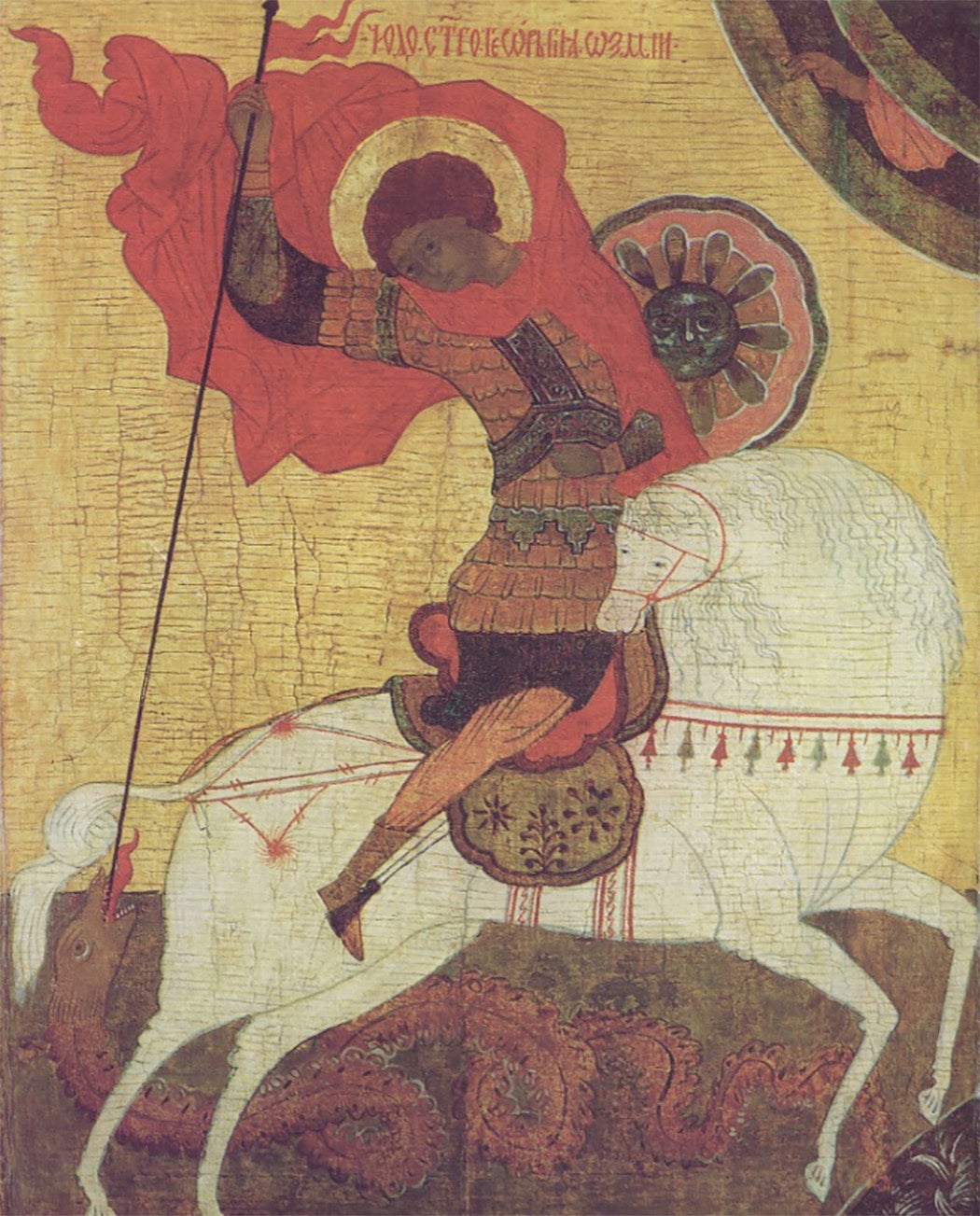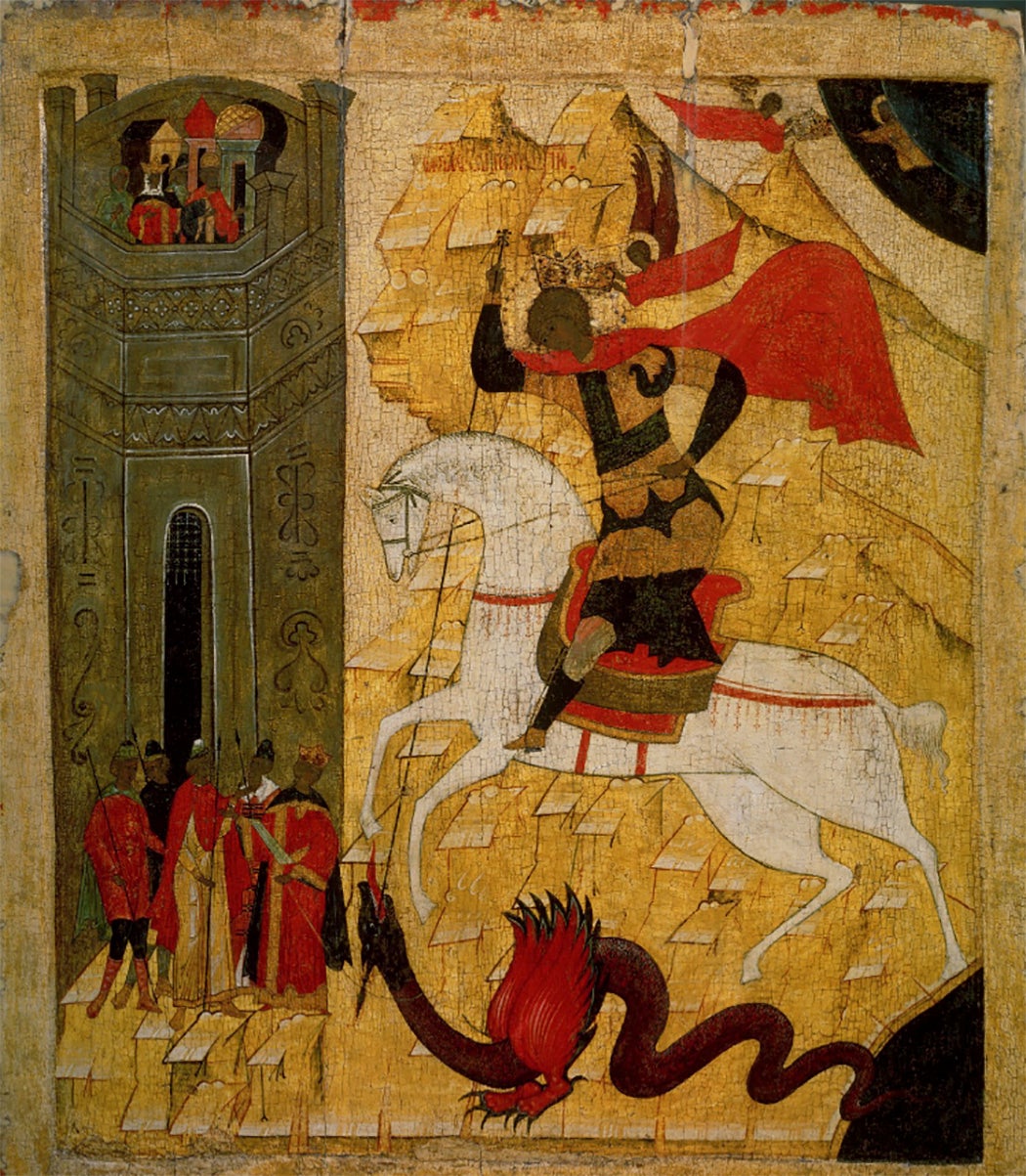The lack of living dragons has never stopped people from drawing them. The trends for dragon design tend to organize along East-West lines: dragons in Asia are snakelike, wingless and benevolent, while European dragons are menacing winged lizards.
When an artist situated right between Asia and Europe—for instance, in Russia—draws a dragon, which region would they draw from? The answer changes throughout the ages, following a steady line that can be tracked through icon-painting.
Weekly Newsletter
Russia is an enigmatic country, impossible to class as European or Asian on a political or cultural basis. Its history started in Kyiv, as the Rus’ kingdom of traders and mercenaries that adopted Christianity from the Byzantines fell, becoming a tributary to the Mongolian Horde. In 988 CE, Russia finally emerged as an independent country, one that clutched its Byzantine Christian beliefs with renewed vigor. A Westernizing movement began around the 1700s. Part and parcel with the Byzantine tradition came icon painting. Despite multiple debacles within the various Russian churches, icon painting has been a major part of Russian religion since the country’s baptism.
Icons are a form of religious artwork very much divorced from the Western idea of realist painting. They are used primarily in Orthodox Christian worship and exist as a way for those praying to have a conduit to the divine. Icons are standardized: while there may be some artistic liberties taken by individual artists, the style of an icon is meant to be extremely uniform. A depiction of Saint George and the Dragon from 2019 should look very similar to a Saint George and the Dragon from 900s. It should carry the types of stylization common to all icons: a lack of realist perspective and exaggerated facial features, for example.
These rules of standardization mean that the differences that do appear in icons are relatively easy to track across eras. Saint George in particular is a very popular saint. He has almost as many countries claiming him as their patron as he has icons painted of him. The story of Saint George, put most simply, is of a soldier who valiantly killed a dragon that was demanding human sacrifice from an innocent town. Icons of Saint George and the Dragon depict the saint on horseback from the side, sending his spear into a dragon, who lies curled up beneath the hooves of his horse.
As time went on, the dragons in Russian icons slowly became more Western in style, a predictable mirror of how Russia slowly accepted a European cultural influence.

This George dates from Russia in the late 1300s. At the point when the icon was made, the strongest cultural influences upon Russia were from Byzantium, the close ally from whom it inherited its religion and iconographic tradition, and the Mongol Tatars, from whose occupation Russia had (relatively) recently freed itself. The lingering Mongolian influence meant that Russian culture most resembled Central Asian rather than European culture. While feet might exist somewhere in the chipped area, it does not seem to have any wings at all. The icon follows the standard layout, and the snakelike dragon is very clearly Asiatic.

Here we have another George and dragon from the same century. This one is from the Novogordian school in the northwest of Russia. The dragon now has feet and wings, but the wings appear more decorative than functional. The body is still snakelike overall, but the addition of wings could be seen to suggest the beginnings of a burgeoning Western influence.

This icon is from the first half of the 1400s, returning to the earlier tradition. Even though Russian politics now featured a heavy movement along the Western border, the image of a dragon is still an Asiatic giant snake, as threatening as it is limbless.

This icon dates from the 1500s and shows many of the changes that were appearing in icons as the European Renaissance emphasized realism and perspective in art. As Russia came into its own as a regional power, the European Renaissance was beginning, and trade was slowly expanding. Around this time, artists began to take more and more liberties with the iconographic tradition: definite buildings start to appear, where previously only nondescript shapes would detail an area. The buildings show some perspective, there are small variations in stylization, and the artist depicts an “in-between” dragon: a lizard-headed and bipedal foe.
By the 1700s, the European influence was very strong in the western parts of Russia. The country’s leaders and noblemen looked towards the West rather than the East for inspiration and artistic influence. In 1735, Baron Stroganov had settled in Petersburg, the city created by Tsar Peter I partly as a bid to invite Western influence into the nation. Tsar Peter began commissioning artists to do works that branched outside of the iconographic tradition.

The most prevalent form of art in Russia, icons also reflected this shift. This particular icon is from the seventeenth century, slightly before the rise of Petersburg’s secular art, but slightly after the tsars had begun expressing interest in Europe. The artists invited into Russia were those taught in the European schools. The dragon in this carving is very European, with four defined limbs and separate wings, the exact sort of dragon someone in Europe might picture when asked to imagine one.

Finally, an icon from 1800s Russia (above) mimics the dragon depicted in a German print from the 15th century (below). By the 1800s, Russia’s closest partner in international affairs was Europe, even to the point of European languages becoming more respected than Russian itself among the nobility, who imitated European culture. George’s dragon here is of the fully European type, a trend that continued into the modern era.

* * *
Russia’s closeness with Europe changed its cultural consciousness, even in such minor aspects as the way an artist pictured a fantasy creature. Culture changes things that people rarely think of, and global exchange manifests in every level of culture, from the details of a religious painting to a country’s political priorities.
Support JSTOR Daily! Join our new membership program on Patreon today.







